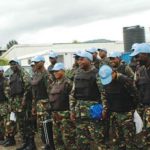As crises multiply around the world, uprooting millions of people within the borders of their country, a group of states, UN agencies and partners have renewed their commitment to working collaboratively to reduce and resolve internal displacement.
At a meeting in Geneva on April 17, they launched a three-year plan of Action for Advancing Prevention, Protection and Solutions for Internally Displaced People (2018-2020). The meeting marked the 20th anniversary of the Guiding Principles on Internal Displacement – widely accepted as being the global standard for protecting and assisting internally displaced people (IDPs).
Internal displacement has been recognized as an issue of global concern since the early 1990s, but momentum to address it has been insufficient, despite all efforts. Meanwhile, the number of IDPs has been rising.
“Bold and ambitious steps are needed to face this complex human rights, humanitarian and development challenge. The Plan of Action seeks to galvanize a strategic dialogue, concerted action and adequate resources to address the plight of the internally displaced, while engaging them in the decisions that affect them,” said the Special Rapporteur on the human rights of IDPs, Cecilia Jimenez-Damary.
At the end of 2016, over 40 million people were displaced inside their own countries by armed conflict, generalized violence or human rights violations – more than four times the population of London or New York City. In 2016, disasters caused an additional 24 million internal displacements. Every year, an estimated 15 million people are also displaced by development projects. Millions of other displacements are not systematically recorded, including from land grabs, criminal violence or drought.
“Addressing the protection needs of the forcibly displaced and seeking solutions to their plight contribute to greater stability for countries and whole regions,” noted UN High Commissioner for Refugees, Filippo Grandi. “Similar to refugees, the internally displaced often face great uncertainty. They can be uprooted more than once as they seek opportunities to restart their lives, and risk being marginalized in the societies where they live. The consequences of our failure to resolve internal displacement can be devastating.”
“The international community has pledged to leave no one behind. That promise must extend to the millions of people internally displaced by armed conflict, violence and disasters. We will continue to work with affected governments and the displaced people themselves to ensure that their needs are addressed,” said Mark Lowcock, Under-Secretary-General for Humanitarian Affairs and Emergency Relief Coordinator.
Drafted under the leadership of the Special Rapporteur, UNHCR and UNOCHA, the multi-stakeholder Plan of Action calls on all relevant actors to step up efforts to prevent, respond to and resolve internal displacement.
To this end, it proposes concrete activities to facilitate and strengthen the participation of internally displaced people in the decisions that concern them, and expand national laws and policies on internal displacement. It recommends as well actions to improve data collection and analysis on displacement situations globally and scale up engagement on solutions for the internally displaced.







